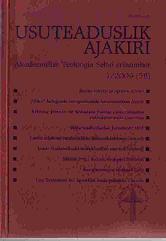„Võõra” kategooria evangeeliumide hermeneutikas. Veelkord võõras Jeesus
The Category of a Stranger in the Hermeneutics of the Gospels. Jesus as a Stranger. Revised
Author(s): Ain RiistanSubject(s): Christian Theology and Religion
Published by: Akadeemiline Teoloogia Selts
Keywords: New Testament Studies; Theology; Hermeneutics
Summary/Abstract: This article appeared first in the publication Kristuse täisea mõõtu mööda. Pühendusteos Jaan Kiivitile 65. sünnipäevaks. Toim Arne Hiob, Urmas Nõmmik, Arho Tuhkru (Tallinn: EELK Usuteaduse Instituut, 2005). Now it is revised for Usuteaduslik Ajakiri. The article models the relations between theological and historical-critical perspectives of studying the gospels using the category of a stranger in the Historical Jesus research. In the beginning of the 20th century Albert Schweitzer described Jesus as a stranger who remains in his own time and who cannot be made relevant for our time in a straightforward manner. This observation has generated numerous responses in the course of time. Karl Barth stressed the importance of faith over the historical research. Rudolf Bultmann separated history and faith from each other altogether. The „new questers” Ernst Käsemann, Günther Bornkamm and Joachim Jeremias sought to do historical analysis from the standpoint of faith. And representatives of the „third quest” have once again stressed the importance of viewing Jesus in the context of his own time and allowing that context to give meaning to it. E.P. Sanders, Gerd Theissen and N.T. Wright follow here many aspects of Schweitzer’s thought. Following Tom Wright it is stated that it is not Jesus who has to be relevant for us; it is for us to take steps to understand him in his own time. Thus we can overcome the division between history and faith introduced into Biblical theology by the Gablerian programme.
Journal: Usuteaduslik Ajakiri
- Issue Year: 2009
- Issue No: 1 (58)
- Page Range: 38-54
- Page Count: 1
- Language: Estonian

